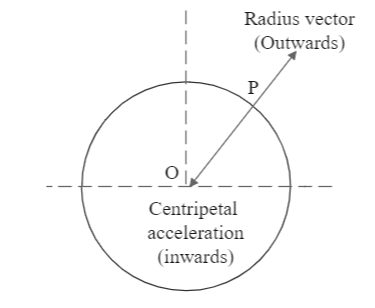
Answer
447.9k+ views
Hint
Centripetal acceleration acts on a body moving in a circular path. It acts towards the centre of the body. The angle between this acceleration and the radius vector can be found by understanding their directions.
Complete step by step answer
Centripetal is similar to ‘central-seeking’. A force that is responsible for generating circular motion in a body is called centripetal force. As we know that force is calculated as the product of mass and acceleration that a body is going through, the acceleration produced by centripetal force is consequently, termed as centripetal acceleration. Since mass is directionless but force is a vector quantity, the direction of the centripetal acceleration is the same as the direction of the force i.e. towards the centre.
In a circular motion, the radius vector points towards the circumference of the motion. It starts from the centre and ends outwards on the surface of the circle.

We can see that the centripetal acceleration acts towards the centre O, while the radius vector acts outwards from the centre towards point P. This implies that these two quantities have exactly opposite directions of operation. Hence, the angle between them is equal to $ \pi $ .
Option (D) is the correct answer.
Note
Centripetal acceleration can be observed with a simple experiment. Take a ball and tie a long thread around it. When you start swinging it using one end of the thread above your head or in front of your body, try to make circular motion. The system constantly moves in a circular path with the help of force provided by you. But the ball does not fall off because of the centripetal acceleration that acts inwards and keeps the system stable.
Centripetal acceleration acts on a body moving in a circular path. It acts towards the centre of the body. The angle between this acceleration and the radius vector can be found by understanding their directions.
Complete step by step answer
Centripetal is similar to ‘central-seeking’. A force that is responsible for generating circular motion in a body is called centripetal force. As we know that force is calculated as the product of mass and acceleration that a body is going through, the acceleration produced by centripetal force is consequently, termed as centripetal acceleration. Since mass is directionless but force is a vector quantity, the direction of the centripetal acceleration is the same as the direction of the force i.e. towards the centre.
In a circular motion, the radius vector points towards the circumference of the motion. It starts from the centre and ends outwards on the surface of the circle.

We can see that the centripetal acceleration acts towards the centre O, while the radius vector acts outwards from the centre towards point P. This implies that these two quantities have exactly opposite directions of operation. Hence, the angle between them is equal to $ \pi $ .
Note
Centripetal acceleration can be observed with a simple experiment. Take a ball and tie a long thread around it. When you start swinging it using one end of the thread above your head or in front of your body, try to make circular motion. The system constantly moves in a circular path with the help of force provided by you. But the ball does not fall off because of the centripetal acceleration that acts inwards and keeps the system stable.
Recently Updated Pages
Who among the following was the religious guru of class 7 social science CBSE

what is the correct chronological order of the following class 10 social science CBSE

Which of the following was not the actual cause for class 10 social science CBSE

Which of the following statements is not correct A class 10 social science CBSE

Which of the following leaders was not present in the class 10 social science CBSE

Garampani Sanctuary is located at A Diphu Assam B Gangtok class 10 social science CBSE

Trending doubts
Which are the Top 10 Largest Countries of the World?

Fill the blanks with the suitable prepositions 1 The class 9 english CBSE

Give 10 examples for herbs , shrubs , climbers , creepers

A rainbow has circular shape because A The earth is class 11 physics CBSE

How do you graph the function fx 4x class 9 maths CBSE

What is pollution? How many types of pollution? Define it

The Equation xxx + 2 is Satisfied when x is Equal to Class 10 Maths

Difference between Prokaryotic cell and Eukaryotic class 11 biology CBSE

Why is there a time difference of about 5 hours between class 10 social science CBSE




